Production Notes - Thunderball
A year before his death in 1963, Ian
Fleming, agreed to an out-of-court
settlement with Kevin
McClory and Jack Whittingham to bring to
an end the lengthy litigation surrounding the novel Thunderball.
On Tuesday 26 November, the complex copyright wrangles came before
Mr Justice Ungoed-Thomas and in the aftermath, McClory walked
away with an additional credit on all subsequent reprints of the
novel and, more importantly, retained the film rights.
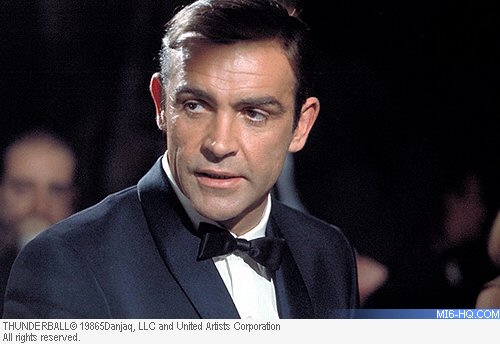
Above: Sean Connery as
James Bond.
|
McClory immediately set to work trying to stage his own big
screen version of the story. On 8 January 1964, The Daily Mail
noted
that McClory was apparently making tracks and made some fairly
derogatory remarks about EON's 'official' entries - "Albert
Broccoli and Harry
Saltzman are following their two earlier Bond
thrillers with Goldfinger, in which Bond plays a desperate life-or-death
golf match. Kevin McClory is making Thunderball, in which a madman
steals an H-bomb and holds the world to ransom."
McClory was even going so far as to claim that he had a partial
cast in place, with three actors being targeted for Bond himself
- McClory refused to name two of them, though it was known that
Laurence Harvey, star of Room at the Top [1959] and The Manchurian
Candidate [1962] was certainly in the frame. Much later, McClory
was to admit that he was also pursuing Richard Burton.
|
McClory formed Bramwell Film Productions
and began rewriting the script that Jack Whittingham had
previously prepared
as early as 1959 (the first time, in fact, that anyone
had attempted to adapt one of Fleming's 007 novels) and
starting
scouting the locations he needed for his film. But it was
some time during this period that McClory seems to have
had a change of heart - rather than go head to head with
EON, as was his original intention, McClory now seemed
to want to collaborate.
In September 1964. McClory approached
Saltzman and Broccoli offering to co-producer Thunderball
as part of the 'official', ongoing series. Saltzman and Broccoli quickly accepted
and an agreement was struck almost immediately. McClory
pocketed 20 per
cent of the film's profits and EON changed the caption
that closed the end credits on Goldfinger reading "James
Bond Will Return In Thunderball."
EON's original plan
had been to produce On Her Majesty's
Secret Service as
their next film and some prints of Goldfinger retained
this promise. On 1 October 1964, Kinematograph Weekly announced
that "Thunderball is to be the next James Bond film...
scheduled for production in February next year.
|
|
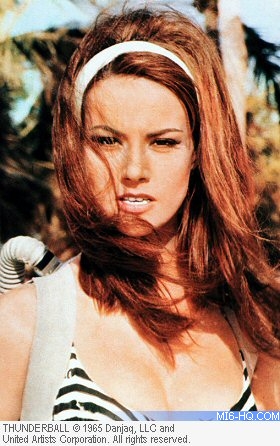 Above:
The leading lady of "Thunderball" - Domino
- played by Claudine Auger. Above:
The leading lady of "Thunderball" - Domino
- played by Claudine Auger.
|
McClory had long harboured the desire to direct
Thunderball himself, though by entering into the agreement with
EON, that was now out
of the question. Broccoli again asked Guy Hamilton to direct,
but he declined, feeling that he had done as much as he could
with the character - he was, in fact, to return for three more
Bond films in the 70s, Diamonds Are Forever, Live
And Let Die and The Man With
The Golden Gun.
Fortunately, Terence Young was available and seems to overcome
his difficulties
with EON for he quickly accepted Saltzman and Broccoli's offer
to return to the fold.
Richard
Maibaum found himself re-writing the script solo, Paul Dehn
having cried off due to prior commitments. His script was given
a polish by veteran British writer John Hopkins who had perfected
his craft on cutting edge TV drama like Sunday Night Theatre and
Z Cars. With the script in shape, EON prepared for shooting by pouring
an unprecedented $5.6 million into the production.
Sean Connery, of course, was set to return as
Bond. Though he was becoming increasingly uneasy about the role,
there
was simply
no-one at that time who could seriously replace him. Connery
was professional enough to tow the party line, however, enthusing
to Roderick Mann of The Daily Mail in February 1965 that "Thunderball
is the best story of them all really" though there were
some hints of his unease - "I think it could be better
than the last one, but I can't see the cycle going on past
that. Though
I am signed to do two more - OHMSS and one other. But who knows?
America seems to lap them up... My only grumble about the Bond
films is that they don't tax one as an actor... I'd like to see
someone else tackle Bond, I must say - though I think they'd
be
crazy to do it."
Nevertheless, on 16 February 1965, Connery duly turned up on
the set in Paris to begin principal photography. He was joined
by the latest Bond girl, Claudine
Auger, who had won the role
of Domino over some stiff competition. Broccoli's original choice
had been Julie Christie who had impressed him with her performance
in Billy Liar [1963]. But when he met her in person, he had been,
allegedly, rather disappointed and turned his attentions instead
on Raquel Welsh who he saw on the cover of the October 1964 issue
of Life. Welsh, was offered the part, but Richard Zanuck lured
her away to Twentieth Century Fox to appear in Fantastic Voyage
[1965].
Faye Dunaway also came close to appearing as Domino and seemed
set to sign on the dotted line until a misguided agent persuaded
her to appear in the less-than-memorable The Happening [1967]
instead. Saltzman and Broccoli went through a whole raft of less
well known actresses in their search for Domino, including former
Miss Italy Maria Grazia Buccella, Yvonne Monlaur, co-star of many
a Hammer film, Maria Menzies and Gloria Paul. When former Miss
France Auger was eventually cast, the script had to be rewritten
partially to make Domino French instead of her original Italian
- though as it turned out, her voice was eventually redubbed in
post production anyway.
|
Cast against Connery's Bond would be Italian actor Adolfo
Celi as SPECTRE agent Emilio Largo, ably assisted by Luciana
Paluzzi (who had lost out to Auger for the Domino role) as
fiery redheaded assassin Fiona Kelly. But Kelly, as written by Maibaum
(she appears in neither
Fleming's novel nor Whittingham's screenplay) was meant to be Irish
and the casting of the Italian actress necessitated a change of character
surname to Volpe. Rik Van Nutter came
on board as the third incarnation of CIA agent Felix Leiter and, like
Auger, was re-dubbed throughout.
Young's first task was to shoot the pre-credit
sequence at the Chateau D'Anet near Paris. The original script
had called for
Bond to pursue his man into a 'fan-tan' strip club in Hong Kong,
but a late revision of the script (dated 16 January 1965) moved
the action to the now familiar funeral.
On 19 February, Young
staged the much-loved sequence wherein Bond makes good his
escape from the Chateau thanks to a Bell
Textron jet pack. The
scene
was of such importance that EON had the only two pilots qualified
to use the rocket-powered device to the set to oversee the
stunt. |
|

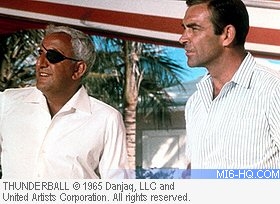
|
Bill Suitor, one of the pilots, was contracted to double for Bond during the
short flight, though he refused to comply with Young's request that he make
the flight without a crash helmet - this later forced Young to go back and
shoot a hastily filmed insert shot of Bond putting on a crash helmet in front
of an obviously back-projected Chateau.
The teaser originally ended with an impressive crane shot as
the camera lifted off to follow Bond's escape in the Aston
Martin DB5. The shot was cut, however, when it was felt that the high
pressure stream of water fired at the pursuing villains would
segue rather neatly with Maurice
Binder's aquatic themed opening
titles.
The production decamped to Bond's spiritual home at Pinewood
Studios where EON set up office and prepared for the lengthy shoot
in the Bahamas. The scenes at Shrublands, the health farm seen
at the beginning of the film were shot first, followed by a trip
to the Silverstone race track to shoot the DB5 in its dramatic
chase with Count Lippe and Fiona Volpe. Young had momentary cause
for alarm when, after the dramatic explosion that destroys Lippe's
car, stunt man Bob Simmons was nowhere to be seen. Fortunately,
Simmons had managed to bail out of the flaming car shortly before
the explosion unseen by the rest of the crew.
Finally, the production upped sticks and headed for the rather
more hospitable climes of Nassau. It was here that Kevin McClory's
real contribution to the production was to be felt - a long time
devotee of all water sports, McClory was able to advise the production
on the best locations and was to help oversee the film's many
underwater scenes.
The amount of sub-aquatic filming presented a unique challenge
to production designer Ken Adam. Not only was he charged with
designing all of the hardware, but also had to build sets underwater,
something that had never been attempted before. He was assisted
in the former task by Jordan Klein, a Miami based expert on mini-submarines
who joined the Bond circus in Nassau to construct working models
from Adam's designs.
The most impressive piece of nautical hardware was undoubtedly
Largo's cruiser, Disco
Volante, which was supposed to divide into
two separate sections at a key moment. $500,000 of the budget
was allocated to buying a hydrofoil, The Flying Fish, which Adam
had picked up in Puerto Rico the previous December and it was
converted into a working version of the Disco Volante. Klein and
his team of engineers worked around the clock to complete the
complex conversion.
On 22 March 1965, the Bond main unit arrived
in Nassau where cast and crew alike luxuriated in the fine Caribbean
weather -
Martine Beswicke, who played Paula Kaplan, was even ordered to
spend part of her working day topping up her suntan! More fun
was had when the production restaged the traditional junkaroo
festival, the parade that Bond escapes through. The real junkaroo
is held on 26 December and enthusiastic locals were only to willing
to give the celebrations a second run-through for the cameras.
|
By far the hardest task awaiting the
crew would be the underwater scenes. The first to be shot
had the production disappearing
beneath the waves to a depth of 50 feet to shoot the scene where
SPECTRE divers remove the nuclear warheads from the crashed Vulcan
bomber. The weapons featured
were obviously fake, but were remarkably realistic thanks
to some dubious work by art director Peter
Lamont - a while
earlier, Lamont had visited an air force base carrying
a concealed camera which he used to get close-up shots
of the still secretive missiles.
Next up came the scene with the sharks
in Largo's pool, a sequence that Connery had been dreading.
Adam built a special
Plexiglas partition inside the pool at Connery's insistence,
the actor swimming safely through a narrow corridor while
the sharks circled menacingly outside. Or at least that
was the plan... What happened in reality was that Adam
hadn't managed to secure as much Plexiglas as he needed
and
the partition didn't actually cut Connery off entirely
from
the
sharks. As the cameras rolled, one of the fish got
through the partition and a panicked Connery was forced
to bale
out of the pool very quickly!
|
|
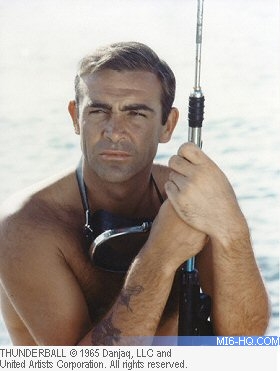
|
There were more problems with sharks in the same sequence. A
dead shark had been rigged on a line and was due to be towed through
the pool to capture the scene where the fish pursues Bond to the
very edge of the pool. John Stears, who was in charge of the film's
special effects, was in the water with the supposedly deceased
shark when it suddenly 'revived' - the fish had only been stunned
and was none too pleased to wake up attached to a rope being dragged
around by special effects men. Stears was dragged from the pool
as the irate shark turned on the other fish and a feeding frenzy
ensued.
Following these mishaps, it's perhaps no surprise to learn that
stunt man Bill Cummings demanded a danger money fee of £250
before he allowed himself, doubling for Largo's sidekick Quist,
to be dropped into the pool. Young himself escaped unscathed,
but reported later that his wife refused to sleep with him for
two weeks because he smelt so badly of fish!
Problems with sharks dealt with, the crew set off for Clifton
Pier where the climactic underwater battle and several other scenes
were to be staged. Ricou Browning, who had once been best-known
as The Creature From the Black Lagoon [1954], was drafted in to
oversee the sub-aquatic shooting. Browning had earned a reputation
in Hollywood for being the leading expert in underwater filming
and was contracted to choreograph and stage the many battle scenes
beneath the Disco Volante.
|
Browning rehearsed his team of divers on a barge before
submerging them for the real thing, filmed by veteran underwater
photographer Lamar Boren whose work on Thunderball surpassed
anything he had previously done for his employers at the
Ivan Tors Studios, home of TV hits Flipper and Sea Hunt.
During the shoot, the production also
received help from EON's 'unofficial' military adviser
and liaison, retired
Royal Air Force Lieutenant-Colonel Charles Russhon who
had already proved his worth by smoothing the way with
local authorities in Turkey (for From
Russia With Love) and at Fort
Knox (for Goldfinger) but who was prove invaluable
here.
Using his many connections,
Russhon was able to gain access to the US Navy's still
experimental Skyhook rescue
system that lifts Bond and Domino from the water at the
end of the film. Russhon also
supplied the experimental rocket fuel used to destroy
the Disco Volante. |
|
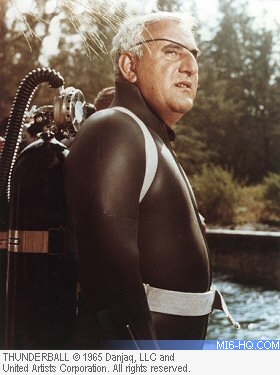
|
Stears, who was charged with rigging the explosion,
only took possession of the fuel the night before the stunt was
due to be filmed and had no idea just how volatile the substance
was. Stears doused the former Flying Fish in the fuel and the
crew
retired to a safe distance. But when the fuel was detonated no-one
expected the results they got - the explosion was tremendous,
so
great in fact that it lifted the boat clean out of the water and
shattered windows in Bay Street, 30 miles away! Stears was to
win
an Academy Award for his work on Thunderball.
May 1965 saw production on Thunderball finally winding down.
The last scene to be shot was the fist fight on the bridge of
the Disco Volante and the raw footage was handed over to Peter
Hunt for editing.
As the shoot neared its conclusion, it became increasingly clear
that Connery was becoming more and more unhappy. His two-and-half-year
old marriage to actress Diane Cilento was breaking down and Connery,
distracted by the problems in his personal life, refused to join
in the usual publicity circus that surrounded every Bond film.
Connery became increasingly agitated with journalists and photographers
who followed him everywhere in Nassau and relented only once,
allowing a single interview with Playboy.
The interview brought Connery's unease into the sharpest focus
yet: "I find that fame tends to turn one from an actor and
a human being into a piece of merchandise, a public institution.
Well, I don't intend to undergo that metamorphosis." In
retrospect, it was clear even now that Connery's days in the
role were numbered.
Connery also turned down an offer to appear in The Incredible
World of James Bond, a promotional TV special being made by Wolper
Productions for broadcast on the NBC network. Sponsors Pepisco
even talked Joan Crawford into going to see Connery to see if
they could persuade him to change his mind, but to no avail. Connery
stood his ground, even after Wolper offered him a fair sized sum
and a cut of the profits, and the special was screened without
him.
|
Maurice
Binder, meanwhile, set about creating
his trademark title sequence, a dispute with EON now resolved
so that
his name could again appear in the credits - his work had
gone uncredited on Goldfinger. Binder had to reshoot
the famous gun barrel scene as Thunderball was the first
Bond film to be shot in Panavision. This allowed Binder
to not only use pinhole photography to shoot inside a genuine
gun barrel, but also allowed Connery to appear in the sequence
for the first time - the 'Bond' seen in the sequence at
the start of Dr No, From Russia With Love
and Goldfinger had been stunt man Bob Simmons, who
could thus legitimately lay claim to being the first of
the big screen Bonds! Binder used the tank at Pinewood
to shoot his silhouetted title girls who appeared naked
(the first time actual nudity had been seen in a Bond film)
which got the film into some trouble with the Spanish authorities.
|
|
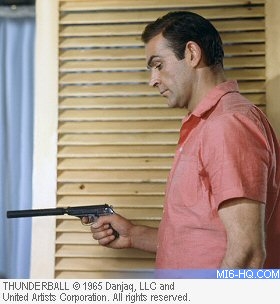
|
John
Barry and Leslie Bricusse's original title song, Mr Kiss
Kiss, Bang Bang, took its title from a comment made in 1962 by
an Italian journalist while covering a publicity tour for Dr No.
He described Bond, with some accuracy, as "Mr Kiss Kiss,
Bang Bang" and the phrase soon cropped up time and again
in connection with Bond. Saltzman and Broccoli were so taken by
the phrase that they not only allowed Barry and Bricusse to write
a whole song around it, but named the night-club in Nassau visited
by Bond and Volpe the Kiss Kiss Bang Bang Club.
The song itself was originally recorded by Goldfinger's Shirley
Bassey but was re-recorded by Dionne Warwick. Then, just weeks
before the film was due to be released, the song was removed from
the opening credits altogether, Saltzman and Broccoli suddenly
worried that a song that didn't mention the title of the film
wasn't going to work. Barry was sent back to work, this time teaming
up for the first of many collaborations with lyricist Don Black,
to write the new song, Thunderball.
Tom Jones, then at the height of his success, was called in to
perform the song. Jones gave his customary full blooded rendition
and actually fainted in the recording studio when he hit the song's
final note. Fortunately, his performance had been spot on first
time and the warbling Welshman didn't have to go back and do it
all again...
Barry was working under almost intolerable conditions. The song
was recorded only days before the film was due to be premiered
and the soundtrack album, issued before the film was released,
was a curious affair. As Barry hadn't actually finished the entire
soundtrack, the album features only music from the first half
of the film!
In a change to the established pattern Thunderball had its premiere
not in London's Leicester Square, but at the Manhattan Paramount
Theater in New York on 21 December 1965.
|
It was an elaborate affair, preceded several
weeks earlier by the erection of a special viewing booth
outside
the cinema where a looped trailer played constantly. At
the premiere, the Bell Textron jet pack made a spectacular
landing, having taken off from the top of the cinema. Sadly,
the pilot and various members of the United Artists publicity
department were arrested because they'd neglected to obtain
the required city license.
The film was another massive
success and a number of cinemas in the larger cities,
including the Paramount, stayed open round the clock to
cram in as
many packed out showings as they could. In Britain, the film had twin opening
galas on 29 December at the Pavilion in Piccadilly Circus
and at the Rialto
just along the road in Coventry Street. followed by a supper
party for the assembled guests (who included Honor Blackman,
Claudine Auger, Adolfo Celi and Martine Beswick, but not
Connery or Saltzman) where it was announced that the twin
galas had raised £60,000 for the Newspaper Press
Fund. Tragically, Broccoli was also unable to attend the
opening of Thunderball - his mother had only recently died
and Broccoli was still to upset to appear. |
|

|
By now, it was becoming almost too predictable
to note the record breaking takings of a new Bond film. But sure
enough, Thunderball's
box office take went through the roof again. It easily saw off
competition from the likes of The Battle of the Bulge, the then-newly
released The Sound of Music and a re-issued Goldfinger, to become
of the most popular films of its year. And not just in Britain
and America - the film was huge throughout Europe (helped, no
doubt, by its plethora of European stars in the supporting cast)
and also in Japan where it set new box office records. Indeed
such was the enthusiasm (some might say hysteria) with which
Bond
was greeted in Japan that EON were to set their next film, You
Only Live Twice, almost entirely in that country. In the
States, Thunderball made more money than any previous Bond film
- a record that has still yet to be broken by subsequent entries.
On 17 June 1965, the London Evening Standard carried a story
noting that the Bond phenomenon had reached such epic proportions
that US TV giant CBS had tried to buy out EON's share in the franchise
to the tune of some $30 million. Allegedly Saltzman and Broccoli
had been tempted and entered into talks with CBS, but the bid
failed when the two parties couldn't reach a resolution over problems
involving "tax problems and division of right."